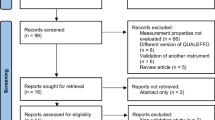Abstract
The quality-of-life questionnaire in osteoporosis (QUALIOST®) is commonly used and accepted generic instrument in osteoporosis. This study aimed to translate QUALIOST® into Turkish language and assess its reliability, validity and acceptability in women with postmenopausal osteoporosis (PMO). After the questionnaire was translated into Turkish, it was administered to 110 with PMO. The reliability studies were assessed by test–retest reliability (ICC) and internal consistency (Cronbach’s alpha). Construct validity was assessed by using correlating QUALIOST® with SF-36. Results showed that ICC values were 0.92, 0.91 and 0.92, for physical domain, emotional domain and total QUALIOST® scores, respectively. Similarly, Cronbach’s alpha was acceptable in all domains (0.85, 0.83 and 0.84, respectively). Significant moderate-to-high correlations were obtained between QUALIOST® and SF-36 dimensions (r value between −0.39 and −0.72, p < 0.001). Also, there were moderate–high correlations between the domains of questionnaire and pain intensity and disease duration (r value between 0.35 and 0.45, p < 0.05). In conclusion, this study, which reported firstly psychometric properties and usefulness of the Turkish QUALIOST®, showed that it is a potentially useful measure with a high validity and reliability standards.
Similar content being viewed by others
References
Kanis JA, Melton LJ III, Christiansen C, Johnston CC, Khaltaev N (1994) The diagnosis of osteoporosis. J Bone Miner Res 9:1137–1141
Ross PD, Ettinger B, Davis JW, Melton LJ III, Wasnich RD (1991) Evaluation of adverse health outcomes associated with vertebral fractures. Osteoporos Int 1:134–140
Cook DJ, Guyatt GH, Adachi JD, Clifton J, Griffith LE, Epstein RS, Juniper EF (1993) Quality of life issues in women with vertebral fractures due to osteoporosis. Arrhritis Rheum 36:750–756
Silverman SL (2005) Quality-of-life issues in osteoporosis. Curr Rheumatol Rep 7:39–45
Johnell O, Kanis JA (2006) An estimate of the worldwide prevalence and disability associated with osteoporotic fractures. Osteoporos Int 17:1726–1733
Guyatt GH, Feeny DH, Patrick DL (1993) Measuring health related quality of life. Ann Intern Med 118:622–629
Cranney A, Coyle D, Pham B, Tetroe J, Wells G, Jolly E, Tugwell P (2001) The psychometric properties of patient preferences in osteoporosis. J Rheumatol 28:132–137
Marquis P, Cialdella P, De la Loge C (2001) Development and validation of a specific quality of life module in post-menopausal women with osteoporosis: the QUALIOST. Qual Life Res 10:555–566
De la Loge C, Sullivan K, Pinkney R, Marquis P, Roux C, Meunier PJ (2005) Cross-cultural validation and analysis of responsiveness of the QUALIOST®: QUAlity of Life questionnaire In OSTeoporosis. Health Qual Life Outcomes 3:69
World Health Organization Study Group (1994) Assessment of fracture risk and its application to screening for postmenopausal osteoporosis. WHO technical report series no.: 843. WHO, Geneva
Cronbach LJ (1951) Coefficient alpha and the internal structure of tests. Psychometrika 16:297–334
DeVellis RF (1991) Scale development: theory and applications. Sage, Newbury Park
Shout PE, Fleiss JL (1979) Intraclass correlations: using in assessing rater reliability. Psychol Bull 86:420–428
Avioli LV (1991) Significance of osteoporosis: a growing international health care problem. Calcif Tissue Int 49(Suppl):S5–S7
Melton LJ III (1993) Hip fractures: a worldwide problem today and tomorrow. Bone 14:S1–S8
Kocyigit H, Aydemir O, Fisek G, Olmez N, Memis A (1999) Kısa form 36 (KF-36)’nın Türkçe versiyonunun güvenilirliği ve geçerliliği. İlaç ve Tedavi Dergisi 12:102–106
Leidig G, Minne HW, Sauer P, Wüster C, Wüster J, Lojen M, Raue F, Ziegler R (1990) A study of complaints and their relation to vertebral destruction in patients with osteoporosis. Bone Miner 8:217–229
Ross PD, Davis JW, Epstein RS, Wasnich RD (1994) Pain and disability associated with new vertebral fractures and other spinal conditions. J Clin Epidemiol 47:231–239
Cook DJ, Guyatt GH, Adachi JD, Clifton J, Griffith LE, Epstein RS, Juniper EF (1993) Quality of life issues in women with vertebral fractures due to osteoporosis. Arthritis Rheum 36:750–756
Andresen EM (2000) Criteria for assessing the tools of disability outcomes research. Arch Phys Med Rehabil 81(Suppl 2):S15–S20
Deyo RA, Centor RM (1956) Assessing the responsiveness of functional scales to clinical changes; an analogy to diagnostic test performance. J Chronic Dis 39:897–906
Author information
Authors and Affiliations
Corresponding author
Rights and permissions
About this article
Cite this article
Hepguler, S., Atamaz, F.C., Pinar, Y. et al. Acceptability, validity and reliability of the Turkish QUALIOST® in postmenopausal women with osteoporosis. Rheumatol Int 33, 757–761 (2013). https://doi.org/10.1007/s00296-012-2443-z
Received:
Accepted:
Published:
Issue Date:
DOI: https://doi.org/10.1007/s00296-012-2443-z



